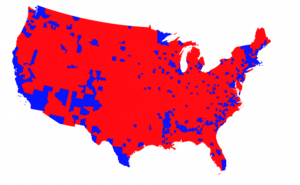There’s a growing number of states that are trying to make themselves completely irrelevant in selecting the President of the United States. The states are doing this of their own free will by passing laws to give their electoral votes to the candidate that receives the largest number of votes across the country.
A Quick Review of How The Electoral College Works
A quick reminder before the rest of the discussion on how the United States chooses its president: Each state is entitled to cast votes in the Electoral College equal to the number of Senators and Representatives the state has. Montana has two Senators and one Representative, thus gets three electoral votes. California has two Senators and 53 Representatives, thus gets 55 electoral votes.
So, with 435 Representatives in the House and 100 members of the Senate, there are 535 possible electoral votes, plus, the 23rd Amendment to the Constitution awards the District of Colombia the same votes as the least populous state, so DC has three votes. This makes a total of 538. To win the presidency a candidate needs an absolute majority, or 270 votes.
A state has the absolute right, through state law to choose the method by which its electors are chosen. This right is defined in the Constitution’s Article II:
“Each State shall appoint, in such Manner as the Legislature thereof may direct, a Number of Electors, equal to the whole Number of Senators and Representatives to which the State may be entitled in the Congress”
Over time, the state legislatures have enacted laws that give all the state’s electoral votes to the presidential candidate that receives the most votes from the people of the state.[1] This system developed to maximize a state’s voice in the Electoral College, and make the state worthy of attention from presidential candidates, and ultimately the president.
The result of this system is that five times (1824, 1876, 1888, 2000, and 2016) the candidate receiving the most popular votes across the country has not won the presidency.
Proposals to Abolish or Change the Electoral College
 This difference between popular vote outcomes and presidential winners has given rise to the argument that the Electoral College should be abandoned for the candidate who wins the most votes in the country. In the alternative, In recent years a proposal gaining support is the National Popular Vote Interstate Compact. Under the proposed compact, if states having 270 or more electoral votes join, those states would cast their votes for the candidate who receives the most votes nationally.
This difference between popular vote outcomes and presidential winners has given rise to the argument that the Electoral College should be abandoned for the candidate who wins the most votes in the country. In the alternative, In recent years a proposal gaining support is the National Popular Vote Interstate Compact. Under the proposed compact, if states having 270 or more electoral votes join, those states would cast their votes for the candidate who receives the most votes nationally.
Most of the energy behind the reform proposals recently has been generated by the outcome of the 2016 election, that saw Hillary Clinton garner the most popular votes nationally, and Donald Trump being elected President with 306 votes in the Electoral College.
2016 Statistics, Nationally and California
Some quick statistics from 2016:
Clinton: Popular vote: 65,845,063; states won: 20 and DC; electoral votes: 227
Trump: Popular vote: 62,980,160’ states won 30’ electoral votes 304[2]
Proponents of electing the president by the national popular vote point out a single number from those statistics. Clinton’s national edge of 2,864,903. There are many other ways to slice and dice the votes, and arguments that campaigns would be different if the rules were different. There is one other statistic that is seldom discussed, the vote in California.
Here’s the California results: Clinton: 8,753,788, Trump: 4,483,810. Clinton’s California margin was 4, 269,978. So, without California, Donald Trump won the popular vote in the rest of the country by 1.4 million votes.
Does the Whole Country Want California Choosing the President?
The president of the United States is to represent the interests of the entire country. Over our history, states have settled on the winner take all system to enhance their influence in selecting the president. Politicians in states other than California supporting proposals to abolish the Electoral College are actually moving to disenfranchise their citizens in presidential elections.
Either the abolishment of the Electoral College or adoption of the National Popular Vote Interstate Compact would essentially result in electing the president from California, when the rest of the country gave the majority of their popular vote to another candidate.
That seems to be the single and simplest argument for leaving the Electoral College as it is.
______________________________________________________________________________________________________
[1] Two states currently do not use winner take all: Maine and Nebraska. In both states, two electors are given to the winner of the state and the other electors are awarded based upon the votes in congressional districts.
[2] There were actually seven electors that did not vote for Clinton or Trump. Aside from 1872 – death of nominee Horace Greeley – it is the greatest number since electors began casting one vote each for president and vice president (12th Amendment, 1804). Three additional faithless votes, one each in Colorado, Maine and Minnesota, were disallowed. Clinton won Washington; however three Electors cast votes for Colin Powell and one for Faith Spotted Eagle. Trump won Texas; however one Elector cast a vote for Ron Paul, another for John Kasich. Clinton won Hawaii; however one Elector cast a vote for Bernie Sanders








[…] When all states finally chose Electors by popular vote[3] it became possible for a presidential candidate to win the vote of the people yet lose in the Electoral College. That happened in 1876, 1888 and 2000. This has been the source of much debate about reforming the Electoral College system. […]